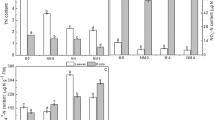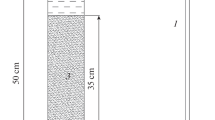Abstract
The improvement of the growth and quality of medicinal plants under stress is of significance, worldwide. The hypothesis was to alleviate salinity stress in Mentha piperita by enhancing nutrient uptake using magnetically treated water, which to our knowledge has not been previously investigated. The objective was to test the effects of magnetized water (using alternating magnetic fields) (main plots, M1-M4 representing control, 100, 200, and 300 mT, respectively), salinity (subplots, S1-S4 representing control, 40, 80, and 120 mM NaCl, respectively), and growth medium (sub-subplots, X1-X4 representing coco peat, palm, coco peat + perlite, and palm + perlite, respectively) on M. piperita nutrient uptake in the greenhouse. The M treatments, especially the 100 and 200 mT levels, significantly increased plant N (1.08%, S3M4X1), P (0.89%, S3M3X1), K (3.23%, S3M3X1), Ca (53.6 mg/kg, S4M4X4), and Mg (39.63 mg/kg, S3M3X2) concentrations (compared with control at 0.71, 0.49, 2.4, 26.63, 1.63) even at the highest level of salinity. Magnetically treated water also significantly enhanced plant Fe and Zn concentration to a maximum of 750 μg/kg (M4S3X1) and 94.67 μg/kg (S4M4X3), under salinity stress, respectively. The single and the combined use of organic and mineral media significantly affected plant nutrient uptake, especially when used with the proper rate of M treatment. If combined with the proper growth medium, the magnetized water may be more effective on the alleviation of salt stress in Mentha piperita by enhancing nutrient uptake.


Similar content being viewed by others
References
Abdani Nasiri A, Mortazaeinezhad F, Taheri R (2018) Seed germination of medicinal sage is affected by gibberellic acid, magnetic field and laser irradiation. Electromagn Biol Med 37:50–56
Alavi SA, Ghehsareh AM, Soleymani A, Panahpour E, Mozafari M (2020) Pepermint (Mentha piperita L.) growth and biochemical properties affected by magnetized saline water. Ecotoxicol Environ Saf 201:110775
Alikamanoglu S, Sen A (2011) Stimulation of growth and some biochemical parameters by magnetic field in wheat (Triticum aestivum L.) tissue cultures. Afr J Biotechnol 10:10957–10963
Azimian F, Roshandel P (2015) Magnetic field effects on total phenolic content and antioxidant activity in Artemisia sieberi under salinity. Indian J Plant Physiol 20:264–270
Bostani A (2018) How amending calcareous soils with municipal solid waste compost affects Fe fractionation and availability to plant. J Trace Elem Med Biol 47:149–155
Doostikhah N, Panahpour E, Nadian H, Gholami A (2020) Tomato (Lycopersicon esculentum L.) nutrient and lead uptake affected by zeolite and DTPA in a lead polluted soil. Plant Biol 22:317–322
Esmaeilnezhad E, Choi HJ, Schaffie M, Gholizadeh M, Ranjbar M (2017) Characteristics and applications of magnetized water as a green technology. J Clean Prod 161:908–921
Eşitken A, Turan M (2004) Alternating magnetic field effects on yield and plant nutrient element composition of strawberry (Fragaria x ananassa cv. Camarosa). Acta Agr Scand B-S P 54:135–139
Ghehsareh AM, Samadi N, Borji H (2011) Comparison of date-palm wastes and perlite as growth substrates on some tomato growing indexes. Afr J Biotechnol 10:4871–4878
Ghehsareh AM, Hematian M, Kalbasi M (2012) Comparison of date-palm wastes and perlite as culture substrates on growing indices in greenhouse cucumber. Int J Rec Organic Waste Agr 1:5
Hachicha M, Kahlaoui B, Khamassi N, Misle E, Jouzdan O (2018) Effect of electromagnetic treatment of saline water on soil and crops. J Saudi Soc Agric Sci 17:154–162
Hoagland, D.R., Arnon, D.I., 1950. The water-culture method for growing plants without soil. Circ. - Calif Agric Exp Stn 347(2nd edit)
Hozayn M, Abdallha MM, El Monem AA, El-Saady AA, Darwish MA (2016) Applications of magnetic technology in agriculture: a novel tool for improving crop productivity (1): canola. Afr J Agric Res 11:441–449
Jamshidi A, Javanmard HR (2018) Evaluation of barley (Hordeum vulgare L.) genotypes for salinity tolerance under field conditions using the stress indices. Ain Shams Eng J 9:2093–2099
Karimi S, Eshghi S, Karimi S, Hasan-nezhadian S (2017) Inducing salt tolerance in sweet corn by magnetic priming. Acta Agriculturae Slovenica 109:89–102
Kataria S, Rastogi A, Bele A and Jain M, 2020. Role of nitric oxide and reactive oxygen species in static magnetic field pre-treatment induced tolerance to ambient UV-B stress in soybean. Physiol Mol Biol Plants in press
Miransari M, Smith DL (2007) Overcoming the stressful effects of salinity and acidity on soybean nodulation and yields using signal molecule genistein under field conditions. J Plant Nutr 30:1967–1992
Miransari M, Bahrami HA, Rejali F, Malakouti MJ (2008) Using arbuscular mycorrhiza to alleviate the stress of soil compaction on wheat (Triticum aestivum L.) growth. Soil Biol Biochem. 40:1197–1206
Miransari M, Smith D (2019) Sustainable wheat (Triticum aestivum L.) production in saline fields: a review. Crit Rev Biotechnol 39:999–1014
Nakabayashi R, Saito K (2015) Integrated metabolomics for abiotic stress responses in plants. Curr Opin Plant Biol 24:10–16
Rathod R, Anand A (2016) Effect of seed magneto-priming on growth, yield and Na/K ratio in wheat (Triticum aestivum L.) under salt stress. Indian J Plant Physiol 21:15–22
Saharkhiz MJ, Goudarzi T (2014) Foliar application of salicylic acid changes essential oil content and chemical compositions of peppermint (Mentha piperita L.). J Essent Oil Bear Plants 17:435–440
Sabet H, Mortazaeinezhad F (2018) Yield, growth and Fe uptake of cumin (Cuminum cyminum L.) affected by Fe-nano, Fe-chelated and Fe-siderophore fertilization in the calcareous soils. J Trace Elem Med Biol 50:154–160
Selim AFH, El-Nady MF (2011) Physio-anatomical responses of drought stressed tomato plants to magnetic field. Acta Astronaut 69:387–396
Shahabifar J, Panahpour E, Moshiri F, Gholami A, Mostashari M (2019) The quantity/intensity relation is affected by chemical and organic P fertilization in calcareous soils. Ecotoxicol Environ Saf 172:144–151
Swanhart S, Weindorf DC, Chakraborty S, Bakr N, Zhu Y, Nelson C, Shook K, Acree A (2014) Soil salinity measurement via portable X-ray fluorescence spectrometry. Soil Sci 179:417–423
Taherian et al (2019) Boron and pigment content in alfalfa affected by nano fertilization under calcareous conditions. J Trace Elem Med Biol 53:136–143
Teixeira da Silva JAT, Dobránszki J (2014) Impact of magnetic water on plant growth. Environ Exp Biol 12:137–142
Teixeira Da Silva JAT, Dobránszki J (2016) Magnetic fields: how is plant growth and development impacted? Protoplasma 253:231–248
Xi G, Fu ZD, Ling J (1994) Change of peroxidase activity in wheat seedlings induced by magnetic field and its response under dehydration condition. Acta Bot Sin 36:113–118
Acknowledgments
The authors would like to thank very much AbtinBerkeh Scientific Ltd. Company (https://AbtinBerkeh.com), Isfahan, Iran, for editing the manuscript, and revising it according to the journal format.
Author information
Authors and Affiliations
Corresponding author
Ethics declarations
Conflict of interest
The authors declare that they have no conflict of interest.
Additional information
Handling Editor: Handling Editor: Peter Nick
Publisher’s note
Springer Nature remains neutral with regard to jurisdictional claims in published maps and institutional affiliations.
Rights and permissions
About this article
Cite this article
Alavi, S.A., Ghehsareh, A.M., Soleymani, A. et al. Enhanced nutrient uptake in salt-stressed Mentha piperita using magnetically treated water. Protoplasma 258, 403–414 (2021). https://doi.org/10.1007/s00709-020-01547-4
Received:
Accepted:
Published:
Issue Date:
DOI: https://doi.org/10.1007/s00709-020-01547-4




